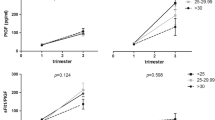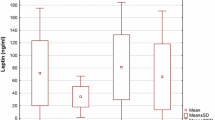Abstract
Purpose
Considerable interest has been focused on angiogenic factors and angiogenic imbalance in the field of pre-eclampsia (PE), owing to its gaining role in the development of PE. This study was addressed to investigate the associations of sFlt-1-to-PlGF plasma ratios with oxidative stress assessed by the level of 8-isoprostane, and inflammation measured by the level of high-sensitive C-reactive protein (hs-CRP), and adipocytokines.
Methods
A total of 83 patients with PE including 47 mild PE (MPE) and 36 severe PE (SPE) and 50 age-matched normotensive subjects in the third trimester of pregnancy were examined. Measurements included body mass index (BMI), systolic and diastolic blood pressure (BP) levels, plasma concentrations of hs-CRP, 8-isoprostane, adiponectin, and leptin.
Results
Subjects with PE had higher levels of sFlt-1/PlGF (P < 0.01), hs-CRP (P < 0.01), 8-isoprostane and leptin (both P < 0.01) and lower adiponectin (P < 0.01) than did normotensive control subjects. Significant positive correlations were found between plasma sFlt-1/PlGF and hs-CRP (r = 0.437, P < 0.01) or leptin (r = 0.656, P < 0.01). A weak inverse correlation emerged between sFlt-1/PlGF and adiponectin (r = −0.306, P < 0.01). When a multiple regression analysis was performed, with sFlt-1/PlGF as a dependent variable and all the other parameters as independent variables, sFlt-1/PlGF maintain a significant relationship with leptin (β = 0.219, P < 0.05) and with hs-CRP (β = 0.295, P < 0.01) as well as with systolic BP(β = 0.446, P < 0.05).
Conclusions
In Chinese preeclamptic women, plasma sFlt-1-to-PlGF ratio is correlated with inflammatory and adipocytokines but not with oxidative stress.




Similar content being viewed by others
References
Sibai B, Dekker G, Kupferminc M (2005) Pre-eclampsia. Lancet 365:785–799
Raijmakers MT, Dechend R, Poston L (2004) Oxidative stress and pre-eclampsia. Rationale for antioxidant clinical trials. Hypertension 44:374–379. doi:10.1161/01.HYP.0000141085.98320.01
Borzychowski AM, Sargent IL, Redman CW (2006) Inflammation and pre-eclampsia. Semin Fetal Neonatal Med 11:309–316. doi:10.1016/j.siny.2006.04.001
Roberts JM, Hubel CA (2004) Oxidative stress in pre-eclampsia. Am J Obstet Gynecol 190:1177–1178. doi:10.1016/j.ajog.2004.04.001
Mutter WP, Karumanchi SA (2008) Molecular mechanisms of preeclampsia. Microvasc Res 75:1–8. doi:10.1016/j.mvr.2007.04.009
Widmer M, Villar J, Benigni A et al (2007) Mapping the theories of preeclampsia and the role of angiogenic factors: a systematic review. Obstet Gynecol 109:168–180
Lam C, Lim KH, Karumanchi SA (2005) Circulating angiogenic factors in the pathogenesis and prediction of preeclampsia. Hypertension 46:1077–1085. doi:10.1161/01.HYP.0000187899.34379.b0
Levine RJ, Maynard SE, Qian C et al (2004) Circulating angiogenic factors and the risk of preeclampsia. N Engl J Med 350:672–683. doi:10.1056/NEJMoa031884
Thadhani R, Mutter WP, Wolf M et al (2004) First trimester placental growth factor and soluble fms-like tyrosine kinase 1 and risk for preeclampsia. J Clin Endocrinol Metab 89:770–775. doi:10.1210/jc.2003-031244
Cohen A, Lim KH, Lee Y et al (2007) Circulating levels of the antiangiogenic marker soluble FMS-like tyrosine kinase 1 are elevated in women with pregestational diabetes and preeclampsia: angiogenic markers in preeclampsia and preexisting diabetes. Diabetes Care 30:375–377. doi:10.2337/dc06-1514
Stepan H, Kramer T, Faber R (2007) Maternal Plasma Concentrations of Soluble Endoglin in Pregnancies with Intrauterine Growth Restriction. J Clin Endocrinol Metab 92:2831–2834. doi:10.1210/jc.2006-2774
Morris JM, Gopaul NK, Endresen MJR et al (1998) Circulating markers of oxidative stress are raised in normal pregnancy and pre-eclampsia. Br J Obstet Gynaecol 105:1195–1199
Redman CWG, Sargent IL (2003) Pre-eclampsia, the placenta and the maternal systemic inflammatory response—a review. Placenta 24:S21–S27. doi:10.1053/plac.2002.0930
Redman CW, Sacks GP, Sargeant IL (1999) Pre-eclampsia: an excessive maternal inflammatory response to pregnancy. Am J Obstet Gynecol 180:499–506. doi:10.1016/S0002-9378(99)70239-5
Bodnar LM, Ness RB, Harger GF (2005) Inflammation and triglycerides partially mediate the effect of prepregnancy body mass index on the risk of pre-eclampsia. Am J Epidemiol 162:1198–1206. doi:10.1093/aje/kwi334
Montuschi P, Barnes PJ, Roberts LJ (2004) Isoprostanes: markers and mediators of oxidative stress. FASEB J 18:1791–1800. doi:10.1096/fj.04-2330rev
Barden A, Beilin LJ, Ritchie J (1996) Plasma and urinary 8-isoprostane as an indicator of lipid peroxidation in pre-eclampsia and normal pregnancy. Clin Sci 91:711–718
Harsem NK, Braekke K, Staff AC (2006) Augmented oxidative stress as well as antioxidant capacity in maternal circulation in preeclampsia. Eur J Obstet Gynecol Reprod Biol 128:209–215. doi:10.1016/j.ejogrb.2005.11.014
Myatt L, Kossenjans W, Sahay R et al (2000) Oxidative stress causes vascular dysfunction in the placenta. J Matern Fetal Neonatal Med 9:79–82. doi:10.3109/14767050009020518
Freeman DJ, McManus F, Brown EA et al (2004) Short- and long-term changes in plasma inflammatory markers associated with pre-eclampsia. Hypertension 44:708–716. doi:10.1161/01.HYP.0000143849.67254.ca
Teran E, Escudero C, Calle A (2005) C-reactive protein during normal pregnancy and pre-eclampsia. Int J Gynaecol Obstet 89:299–300. doi:10.1016/j.ijgo.2005.02.002
Brown MA, Lindheimer MD, de Swiet M et al (2001) The classification and diagnosis of the hypertensive disorders of pregnancy: statement from the International Society for the Study of Hypertension in Pregnancy (ISSHP). Hypertens Pregnancy 20:IX–XIV. doi:10.1081/PRG-100104165
Robinson CJ, Johnson DJ, Chang EY et al (2006) Evaluation of placenta growth factor and soluble Fms-like tyrosine kinase 1 receptor levels in mild and severe preeclampsia. Am J Obstet Gynecol 195:255–259. doi:10.1016/j.ajog.2005.12.049
Masuyama H, Nakatskasa H, Takamoto N (2007) Correlation between soluble endoglin, vascular endothelial growth factor receptor-1, and adipocytokines in preeclampsia. J Clin Endocrinol Metab 92:2672–2679. doi:10.1210/jc.2006-2349
Karumanchi SA, Bdolah Y (2004) Hypoxia and sFlt-1 in preeclampsia: the “chicken-and-egg” question. Endocrinology 145:4835–4837. doi:10.1210/en.2004-1028
Benyo DF, Smarason A, Redman CW et al (2001) Expression of inflammatory cytokines in placentas from women with pre-eclampsia. J Clin Endocrinol Metab 86:2505–2512. doi:10.1210/jc.86.6.2505
Walsh SW (1998) Maternal-placental interactions of oxidative stress and antioxidants in pre-eclampsia. Semin Reprod Endocrinol 16:93–104. doi:10.1055/s-2007-1016256 PMID: 9654611
Suwaki N, Masuyama H, Nakatsukasa H et al (2006) Hypoadiponectinemia and circulating angiogenic factors in overweight patients complicated with pre-eclampsia. Am J Obstet Gynecol 195:1687–1692. doi:10.1016/j.ajog.2006.04.003
Ouyang YQ, Chen HP, Chen HZ (2007) Reduced adiponectin and elevated leptin in plasma from preeclampstic subjects. Int J Obstet Gynecol 98:110–114. doi:10.1016/j.ijgo.2007.04.021
Lappas M, Permezel M, Rice GE (2005) Leptin and adiponectin stimulate the release of proinflammatory cytokines and prostaglandins from human placenta and maternal adipose tissue via nuclear factor-{kappa}B, peroxisomal proliferator-activated receptor-{gamma} and extracellularly regulated kinase 1/2. Endocrinology 146:3334–3342. doi:10.1210/en.2005-0406
Staff AC, Braekke K, Harsem NK (2005) Circulating concentrations of sFlt1 (soluble fms-like tyrosine kinase 1) in fetal and maternal serum during pre-eclampsia. Eur J Obstet Gynecol Reprod Biol 122:33–39. doi:10.1016/j.ejogrb.2004.11.015
Levine RJ, Qian C, Maynard SE et al (2006) Serum sFlt1 concentration during preeclampsia and mid-trimester blood pressure in healthy nulliparous women. Am J Obstet Gynecol 94:1034–1041. doi:10.1016/j.ajog.2005.10.192
Gilbert JS, Ryan MJ, LaMarca BB (2008) Pathophysiology of hypertension during preeclampsia: linking placental ischemia with endothelial dysfunction. Am J Physiol Heart Circ Physiol 294:H541–H550. doi:10.1152/ajpheart.01113.2007
Acknowledgments
We thank Dr. Marcia Petrini, a professor of Thiel University, for assistance in reviewing of the manuscript.
Conflict of interest statement
There is no conflict of interest in such areas as expert testimony, consulting, honoraria, stock holdings, equity interest, ownership, patent-licensing situations, or employment. No conflicts for other reasons such as personal relationships and academic competition. The listing of institutional affiliations on the title page of this manuscript is proper and does not imply a conflict of interest. None of all authors has a conflict of interest to declare in relation to this work.
Author information
Authors and Affiliations
Corresponding author
Rights and permissions
About this article
Cite this article
Ouyang, YQ., Li, SJ., Zhang, Q. et al. Plasma sFlt-1-to-PlGF ratio is correlated with inflammatory but not with oxidative stress in Chinese preeclamptic women. Arch Gynecol Obstet 280, 91–97 (2009). https://doi.org/10.1007/s00404-008-0874-2
Received:
Accepted:
Published:
Issue Date:
DOI: https://doi.org/10.1007/s00404-008-0874-2




